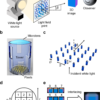New research has unveiled an advancement in Light Detection and Ranging (LIDAR) technology, offering unparalleled sensitivity and precision in measuring the distance of remote objects.
This research, published in Physical Review Letters, is a result of a collaboration between the group of Professor Yoon-Ho Kim at POSTECH in South Korea, and the Quantum Science and Technology Hub at the University of Portsmouth.
Coherent LIDAR has long been a cornerstone in distance measurement, but its capabilities have been restrained by the coherence time of the light source. In a pioneering move, researchers have introduced two-photon LIDAR, eliminating the range limitations imposed by coherence time, to achieve accurate and precise ranging of a remote object situated far beyond the coherence time dictated by the spectral bandwidth of the light source.
The research, inspired by recent works led by Professor Vincenzo Tamma, Director of the Quantum Science and Technology Hub, capitalizes on two-photon interference of thermal light beyond coherence. Unlike traditional coherent LIDAR, where the coherence time is a limiting factor, the second-order interference fringes in Coherent Two-Photon LIDAR remain unaffected by the short coherence time of the light source, determined by its spectral bandwidth.
The experimentally demonstrated scheme takes advantage of a simple thermal light source, e.g. sun light, interacting with a double slit mask with two slits A and B separated beyond the coherent length of the source, and two cameras. The light emitted by the two slits either takes a path of known optical length towards the first detector D1 or propagates towards a remote object at an unknown distance and after being reflected by it is detected by the second detector D2.
Recent research led by Professor Tamma, in collaboration with the University of Bari and POSTECH in South Korea, first theoretically demonstrated that, even in the presence of turbulence, it is possible to estimate the distance of the remote object by measuring the spatial correlations in the intensities of the light detected by the two detectors.
The sensitivity to the unknown distance from the double slit to the object is a consequence of the phase-dependent interference between two two-photon paths: i) from pinhole A to detector D1 and from pinhole B to detector D2; and ii) from pinhole A to D2 and from pinhole B to D1. It is in such a phase-dependent interference that the value of the distance of the object is encoded and



